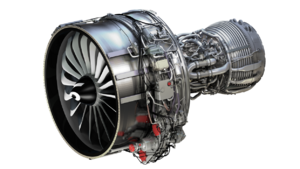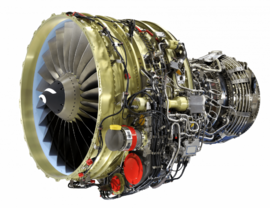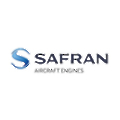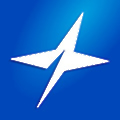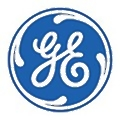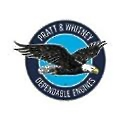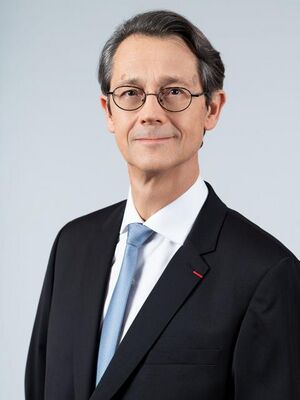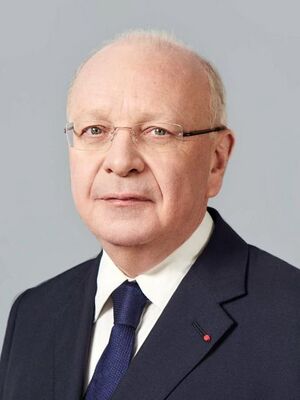Safran SA: Difference between revisions
| Line 243: | Line 243: | ||
{| class="wikitable" | {| class="wikitable" | ||
| rowspan="2" | | | rowspan="2" | | ||
!Safran Aircraft Engines <div style="width: 100px; height: 100px; border-radius: | !Safran Aircraft Engines <div style="width: 100px; height: 100px; border-radius: 100%; overflow: hidden; display: inline-block;"> | ||
[[File:Safran aircraft.png|center|thumb]] | [[File:Safran aircraft.png|center|thumb]] | ||
</div> | </div> | ||
Revision as of 13:27, 20 July 2023
 | |
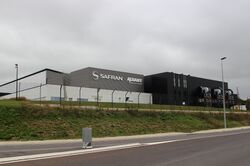 | |
| Type | Société Anonyme |
|---|---|
| Euronext: SAF CAC 40 Component | |
| Industry | Aerospace Defense |
| Predecessor | Snecma, Sagem |
| Founded | 2005 |
| Headquarters | , |
Key people | Olivier Andriès (CEO) Ross McInnes (Chairman) |
| Products | Aircraft engines, equipment, and interiors, defence electronics, avionics, navigation system, communications systems, satellites |
| Revenue | |
| Total assets | |
| Total equity | |
Number of employees | 81,000 (2020) |
| Subsidiaries | OEMServices Safran Aero Boosters Safran Aerosystems Safran Aircraft Engines Safran Cabin Safran Ceramics Safran Electrical & Power Safran Electronics & Defense Safran Helicopter Engines Safran Landing Systems Safran Nacelles Safran Passenger Solutions Safran Seats Safran Transmission Systems ArianeGroup (50% ownership) |
| Website | |
Safran is committed to catalyzing aviation safety and sustainability with innovative solutions.[1]
The company is renowned for its commitment to innovation and excellence. Operating across aircraft propulsion, aircraft equipment, and defense segments, Safran delivers cutting-edge solutions that cater to the evolving needs of the aviation and defense industries worldwide. With a strong focus on research and development, the company continuously pushes the boundaries of technology, striving to enhance the performance, efficiency, and sustainability of its products while fostering collaborative industry partnerships to drive progress in these domains.[1]
Operations
Company history[2]
- 1896: Maurice Mallet, Antonino Mélandri, and Paul Simard de Pitray found "Mallet, Mélandri et de Pitray," later merged with Zodiac in 2018.
- 1905: The Seguin brothers establish "Société des moteurs Gnome" for rotary airplane engines, leading to the merger with "Société des moteurs Le Rhône" in 1915, thus forming "Société des Moteurs Gnome & Rhône."
- 1911: Hispano-Suiza settles in Levallois, France, producing automobiles and later venturing into aircraft engine manufacturing.
- 1920: Messier Automobiles is founded, evolving into SFMA and later Messier, specializing in aircraft landing gear.
- 1930: Messier achieves a major milestone by developing the world's first automatic aircraft brake.
- 1938: Joseph Szydlowski establishes Turbomeca, specializing in aircraft engine compressors.
- 1945: Gnome & Rhône is nationalized and renamed Snecma (Société Nationale d'Etude et de Construction de Moteurs d'Aviation), consolidating most French aero-engine manufacturers.
- 1955: Turbomeca's "Artouste" engine powers the Alouette II, the world's first mass-produced turbine helicopter.
- 1961: Sagem achieves a significant milestone with the successful flight of the first French satellite, guided by their innovative inertial reference system.
- 1968: Hispano-Suiza joins Snecma, adding its expertise in aircraft equipment manufacturing, and shortly after, Messier also becomes part of Snecma.
- 1974: Snecma enters the commercial aviation engine market by partnering with General Electric Aircraft Engines to develop the CFM56 turbofan engine, one of the best-selling aircraft engines globally.
- 2005: The merger of Snecma and Sagem gives birth to Safran, a major aerospace, defense, and security group, unifying their strengths and expertise to provide innovative solutions to the industry.
What's the mission of the company?
Safran's purpose is to design, build, and support high-tech solutions that contribute to a safer, more sustainable world. They strive to make air transport environmentally friendly, comfortable, and accessible while addressing critical needs like defense and space exploration.[3]
Offerings
Safran's core offerings are centered around two primary segments: (1) Aerospace Propulsion and (2) Electronics & Defense.[4]
Aerospace Propulsion
The Aerospace Propulsion segment includes the production of aircraft engines, propulsion systems, landing gear, avionics systems, and aircraft interiors, along with providing after-sales services and aircraft electrical systems. Here we will present the different civil engines:
CFM56
The CFM International CFM56 series, hailed as the world's best-selling engine in aviation history, also known as the F108 in the U.S. military, represents a collaborative family of high-bypass turbofan aircraft engines produced by CFM International (CFMI). These engines offer a versatile thrust range, spanning from 18,500 to 34,000 lbf (82 to 150 kN), making them suitable for a wide array of aviation applications.[5]
LEAP ("Leading Edge Aviation Propulsion")
The CFM International LEAP is a cutting-edge high-bypass turbofan engine manufactured by CFM International, which is a 50-50 joint venture between GE Aviation from the United States and Safran Aircraft Engines (formerly Snecma) from France. As an evolutionary successor to the CFM56 engine, the LEAP engine directly competes with the Pratt & Whitney PW1000G to provide powerful propulsion options for narrow-body aircraft. With its advanced technology and design, the LEAP engine offers exceptional performance and efficiency, positioning itself as a leading choice for modernizing and enhancing the capabilities of commercial aircraft.[5]
LEAP-X & CFM56-5/7 comparison [6]
The LEAP (Leading Edge Aviation Propulsion) series engine, an upgraded version of the CFM56-5/7 series. This engine is designed to provide power for the next generation of single-aisle commercial jets.
| Engine series | LEAP-X | CFM56-5/7 |
|---|---|---|
| Fan | 18 blades | 36 blades |
| LPC | 3 stages | 4/3 stages |
| HPC | 10 stages | 9 stages |
| Combustor | Twin Annular Premixing Swirler (TAPS II) | conventional |
| HPT | 2 stages | 1 stage |
| LPT | 7/5 stages | 4 stages |
| Total core stages | 22 stages | 18 stages |
| Model | Application | Thrust range | In service |
|---|---|---|---|
| LEAP-1A | Airbus A320 neo family | 24,500-35,000 lbf (109-156 kN) | Aug 2016 |
| LEAP-1B | Boeing 737 MAX family | 23,000-28,000 lbf (100-120 kN) | May 2017 |
| LEAP-1C | COMAC C919 | 27,980-31,000 lbf (124.5-137.9 kN) | 2020/2021 |
| Model | Fan diameter | Bypass ratio | Weight (wet) | Thrust to weight (wet) ratio |
|---|---|---|---|---|
| LEAP-1A | 78 in (198 cm) | 11:1 | 6.632 lb (3.008 kg) | 5.3 |
| LEAP-1B | 69.4 in (176 cm) | 9:1 | 6.128 lb (2780 kg) | 4.5 |
| LEAP-1C | 78 in (198 cm) | 11:1 | 6.632 lb (3.008 kg) | 4.6 |
Rival comparison[6]
The primary competitor engines of the LEAP is the Pratt & Whitney's PW1000G (also known as the PurePower PW1000G) series. The PW1000G engine is part of Pratt & Whitney's geared turbofan (GTF) technology, which aims to improve fuel efficiency, reduce emissions, and lower noise levels. Both the LEAP and PW1000G engines are designed to power the next generation of single-aisle commercial aircraft and are competitors in the market for narrow-body jet engines.
| Engine series | LEAP-X | PW1000G |
|---|---|---|
| Fan | 18 blades | 20 blades (PW1100G) |
| Fan gear | - | The reduction gear box (5 planetary gears) |
| LPC | 3 stages | 3/2 stages |
| HPC | 10 stages | 8 stages |
| Combustor | Twin Annular Premixing Swirler (TAPS II) | Lean-burn (TalonX) |
| HPT | 2 stages | 2 stages |
| LPT | 7/5 stages | 3 stages |
| Total core stages | 22 stages | 16 stages |
| Criteria | LEAP-X Engine | PW1000G Engine |
|---|---|---|
| Propulsive Efficiency | Larger fan diameter allows higher bypass ratio, leading to improved propulsive efficiency and fuel savings. | Gear system optimizes fan and LP spool rotation, potentially enhancing propulsive efficiency. |
| Thermal Efficiency | New generation combustion system and advanced materials increase thermal efficiency. Higher operating temperatures require additional cooling systems and materials. | New generation combustion system and advanced materials improve thermal efficiency. Higher operating temperatures necessitate additional cooling systems and materials. |
| Noise Reduction | Designed with noise reduction in mind. Centrifugal FOD ejection system helps protect against debris-induced noise. | Gear system allows for lower fan rotation speeds, contributing to noise reduction. |
Electronics[1]
Avionics and Flight Control Systems: Safran leads in avionics development, offering advanced flight control systems, fly-by-wire technology, and cockpit displays for commercial and military aircraft. Their systems ensure precise control, enhancing safety and pilot awareness. Renowned flight management systems optimize paths, reducing fuel consumption and operational costs for airlines.
Electro-Optics and Infrared Systems: Safran excels in electro-optics and infrared systems, enabling day and night vision for defense and security applications. These systems support surveillance, reconnaissance, and target acquisition, providing critical data in challenging environments. Widely used in UAVs, Safran's technology enhances intelligence gathering.
Communication and Data Security: In the Electronics & Defense sector, Safran offers secure communication and data solutions for military and government entities. Encrypted systems protect sensitive information, guarding against cyber threats. Safran's commitment to data security ensures critical military communications are safeguarded in an interconnected world.
Defense[1]
Navigation and Identification Systems: Safran's defense solutions encompass advanced navigation systems that provide accurate and reliable positioning for military platforms, ensuring precise mission execution and effective deployment of resources. Additionally, their identification systems play a pivotal role in friend-or-foe recognition, minimizing the risk of friendly fire incidents during operations and enhancing overall combat safety.
Optronics and Targeting Systems: Safran's optronics solutions are deployed across various military platforms, offering superior target acquisition and tracking capabilities. These systems, integrated into armored vehicles, helicopters, and UAVs, provide enhanced situational awareness and increased accuracy for precision strikes, thus bolstering the effectiveness of military missions.
Drone Solutions: Safran's drone technologies cater to both military and civilian applications. Their unmanned aerial systems (UAS) offer intelligence, surveillance, and reconnaissance capabilities for defense operations, providing real-time data and enhancing the tactical decision-making process. Safran's expertise in drone technology makes them a key player in the rapidly evolving field of unmanned systems.
Research and development
Open rotor
Hydrogen engine
Market
Total Addressable Market
The Total Addressable Market (TAM) for Safran SA is defined as the global aerospace and defense market. According to industry reports, the global aerospace and defense market was valued at $855.62 billion in 2023 and is projected to reach $1076.56 billion by 2027, experiencing a compound annual growth rate (CAGR) of 5.9%.[7]
Serviceable Available Market
The Serviceable Available Market (SAM) for Safran SA is focused on the commercial aviation segment within the global aerospace and defense market. The Commercial Aviation Market is anticipated to experience significant growth, projected to increase from $218.97 billion in 2023 to $271.96 billion by 2028, representing a Compound Annual Growth Rate (CAGR) of 4.43% during the forecast period from 2023 to 2028.[8]
Serviceable Obtainable Market
The Serviceable Obtainable Market (SOM) for Safran SA is focused on the commercial aviation engine market, which represents a significant segment within the broader commercial aviation industry. The global aircraft engine market size is projected to hit USD 112.61 billion by 2029, with a forecasted Compound Annual Growth Rate (CAGR) of 10.87% during the forecast period from 2023 to 2028. The market size stood at USD 54.70 billion in 2022.[9]
Competition
Competitors
Aerospace Propulsion
| Safran Aircraft Engines | Spirit AeroSystems | GE Aerospace | Pratt & Whitney | AECC Aviation Power | |
|---|---|---|---|---|---|
| Safran Aircraft Engines (formerly known as Snecma Moteurs) is a company that designs, develops, produces and markets engines for civil and military aircraft. | Spirit AeroSystems is a manufacturer and supplier of aerostructures for commercial and defense aerospace programs. | GE Aerospace (formerly known as GE Aviation, Smiths Aerospace, General Electric Aircraft Engines (GEAE), also known as GE Aviation Systems) is a manufacturer and service provider of jet engines. | Pratt & Whitney is a company that specializes in the design, manufacture, and service of aircraft engines and auxiliary power units | AECC Aviation Power (中国航发动力股份有限公司, formerly known as AVIC Aviation Engine (中国航发西安航空发动机有限公司)) is an aerospace company that develops, produces, and repairs large, medium and small military and civilian aviation engines, and gas turbine power units for large ships. | |
| Founding Date | 1997 | 2005 | 1917 | 1925 | 1993 |
| Type | Subsidiary | Public | Subsidiary | Subsidiary | Public |
| Tags | Manufacturing & Industrial | Manufacturing & Industrial | Manufacturing & Industrial | Manufacturing & Industrial | Manufacturing & Industrial |
| aerospace | aerospace | aerospace | aerospace | aerospace | |
| aviation | aviation | aviation | aviation | aviation | |
| engines | defense | engines | engines | engines | |
| distribution | mechanical components | machinery | |||
| engines | solar | ||||
| mechanical components | |||||
| Locations | Paris, FR (HQ) | Wichita, US (HQ) | Evendale, US (HQ) | East Hartford, US (HQ) | Xi'an, CN (HQ) |
| Zaventem BE | Montoir De Bretagne, FR | Bromont, CA | Enfield, CA | ||
| Chengdu, CN | Subang, MY | Suzhou, CN | Longueuil, CA | ||
| Guiyang CN | Casablanca, MA | Prague Letnany, CZ | Mirabel, CA | ||
| Shanghai, CN | Belfast, GB | Veresegyház, HU | Mississauga, CA | ||
| Suzhou, CN | Prestwick GB | Seoul, KR | Ottawa, CA | ||
| Tianjin, CN | Dallas, US | Dzierzoniow PL | Beijing CN | ||
| Employees | 12,306 | 18,235 | 29,476 | 19,865 | 34,195 |
Competitive advantage
Team
Board of Directors
Chief Executive Officer and Director
Olivier Andriès' illustrious career has seen him play significant roles in prominent companies, encompassing distinguished positions at the French Ministry of Finance's Treasury department and the prestigious Lagardère group. In the year 2000, he embarked on a transformative journey when he joined Airbus as Vice President, subsequently elevating to the position of Executive Vice President of Strategy. His strategic vision and exceptional performance caught the industry's attention, propelling him further along the path of success.
In 2008, Olivier Andriès set his sights on new horizons, making a strategic move to Safran, where he assumed the crucial role of Executive Vice President of Strategy and Development. His leadership prowess was undeniable, leading to his subsequent appointment as CEO of Turbomeca and Safran Aircraft Engines, solidifying his status as a key decision-maker within the organization. Recognized for his unparalleled acumen and transformative approach, Andriès was the natural choice to be appointed as Safran's next CEO in 2019, with his tenure set to begin on January 1st, 2021.[10]
Chairman of the Board
Ross McInnes, born in 1954, holds the distinction of having dual French and Australian nationality. His distinguished career has seen him play significant roles in prominent companies, making valuable contributions in various executive positions. After Oxford University, he started his career in 1977 at Kleinwort Benson, gaining valuable experience in London and Rio de Janeiro. In 1980, he joined Continental Bank (now Bank of America), contributing significantly in corporate finance in Chicago and Paris.
Ross McInnes joined Eridania Beghin-Say in 1989, becoming CFO in 1991 and a Board member in 1999. He later joined Thomson-CSF (now Thales) in 2000 as EVP and CFO, playing a crucial role in the group's transformation.
Having demonstrated exceptional leadership and expertise, Ross McInnes joined Safran in March 2009 as Executive Vice President for Economic and Financial Affairs. His outstanding performance led to his appointment as a member of the Executive Board from July 2009 to April 2011 and later as Deputy Chief Executive Officer until April 2015. On April 23, 2015, he was appointed Chairman of the Board of Safran.[10]
References
- ↑ 1.0 1.1 1.2 1.3 https://www.safran-group.com/
- ↑ https://www.safran-group.com/group/history-and-heritage/timeline
- ↑ https://www.safran-group.com/news/safran-unveils-its-purpose-statement-2020-06-23
- ↑ https://www.safran-group.com/pressroom/safran-reports-full-year-2022-results-2023-02-17
- ↑ 5.0 5.1 https://www.safran-group.com/products-services?category%5B0%5D=342-commercial-aircraft-engines
- ↑ 6.0 6.1 https://www.linkedin.com/pulse/rivalry-new-generation-engines-lepa-x-pure-power-pw1000g-daugilis/
- ↑ https://www.researchandmarkets.com/reports/5781267/aerospace-and-defense-global-market-report
- ↑ https://www.mordorintelligence.com/industry-reports/commercial-aircraft-market
- ↑ https://www.fortunebusinessinsights.com/industry-reports/aircraft-engine-market-101766
- ↑ 10.0 10.1 https://www.safran-group.com/group/profile/governance
